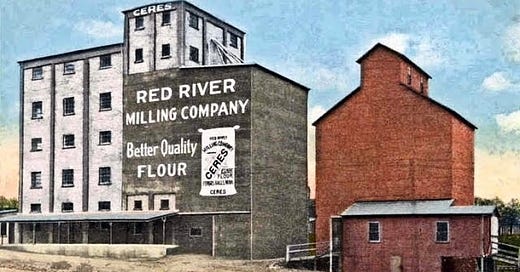Red River Milling Company in Moorhead
Bruns constructed a steam-powered flour mill in Moorhead in 1874
The old Moorhead Flour Mill, established in 1874 by entrepreneur Henry A. Bruns, played a pivotal role in transforming Moorhead, Minnesota, from a modest frontier settlement into a significant hub of agricultural commerce in the Red River Valley.
Origins and Innovation
In the early 1870s, Bruns, recognizing the agricultural potential of the region, introduced wheat cultivation by distributing 500 bushels of seed wheat to farmers in Clay and Norman counties. Despite initial setbacks due to grasshopper infestations, the wheat thrived by 1873, leading Bruns to ship the first carload of Red River Valley wheat to Lake Superior for milling.
Capitalizing on this success, Bruns constructed a steam-powered flour mill in Moorhead in 1874. The mill produced high-quality bread flour under the "Belle of Moorhead" label, which garnered first premium awards at the Minnesota State Fair for two consecutive years. This acclaim not only boosted the mill's reputation but also underscored Moorhead's emerging significance in the flour industry.
Expansion and the Grain Elevator
As wheat production surged, the need for efficient storage and processing became evident. In response, Bruns partnered with Henry G. Finkle in 1878 to construct the first steam-powered grain elevator in the Red River Valley. This facility could handle nearly 250,000 bushels of wheat during its first harvest season, significantly enhancing the region's grain handling capacity.
The elevator's construction was not without controversy. The Northern Pacific Railway, aiming to prevent competition between Moorhead and neighboring Fargo, advised against its immediate construction. However, Bruns and Finkle proceeded, underscoring their commitment to Moorhead's growth and autonomy in the grain industry.
Decline and Legacy
Despite early successes, Bruns's later ventures into banking and hospitality did not fare well, leading to financial losses.By 1893, he relocated to Minneapolis, where he lived modestly until his death.
The grain elevator and mill changed ownership multiple times in the ensuing years. In 1903, Dwight Baldwin acquired both, relocating part of the elevator closer to the mill—a process that proved more challenging than anticipated. Tragically, both halves of the original elevator were destroyed by fire in the 1910s, with the final structure, known as the Baldwin elevator, burning down in 1919.
Today, while the original structures no longer stand, their impact on Moorhead's development is undeniable. The mill and elevator not only catalyzed the city's economic growth but also positioned it as a key player in the broader narrative of Minnesota's agricultural and industrial history.




